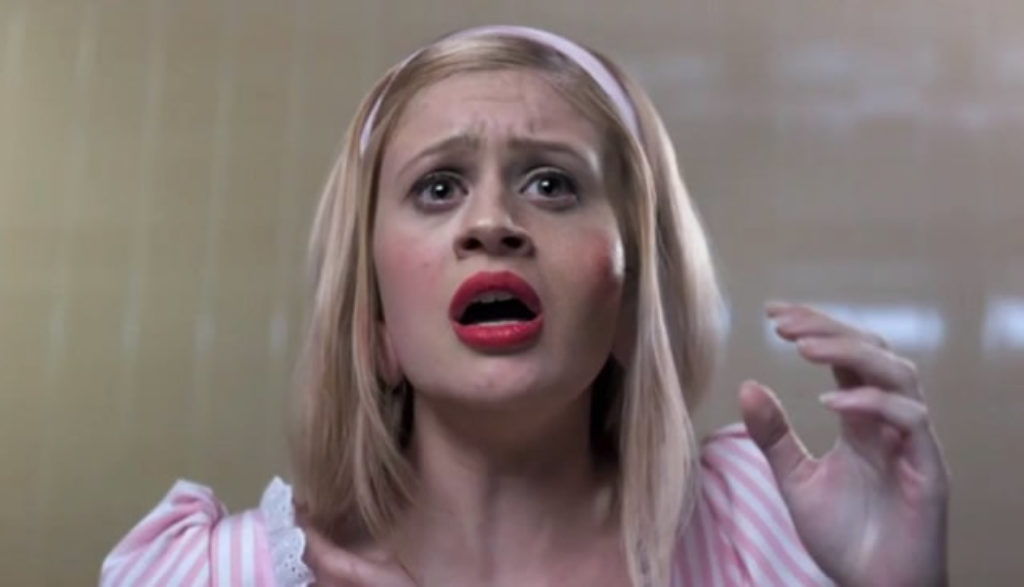
Stella Nichols may look like your average teen high schooler, struggling with her own insecurities and hopes for the future.
But she’s also more.
Or maybe less is more accurate.
When Stella’s mom up and left back when Stella was just a girl, the woman unknowingly gave her daughter some terrible burdens. Stella feels responsible for Mom leaving. She feels responsible for the care of her emotionally wounded father. She feels responsible for being good, being smart, being … responsible. And each of those layers has its own cast iron weight. All those oversize worries make Stella—who she is and who she could be—feel that much smaller.
It’s no wonder that Stella only has the strength for two real friendships. And when she accidentally causes good buds Chuck and Auggie harm, she feels the desperate responsibility to fix things. But I’m getting ahead of the story.
It all starts with a Halloween night. And a book.
You see, Stella, Chuck and Auggie were out enjoying their last Halloween together before graduation and they got into an altercation with the town bully. That drove them into the car owned by a guy named Ramón. And that drove them all to run away from the bully and off to a shambling old house.
While at the old Bellows house—a place that’s been abandoned and locked up for years—the quartet stumble upon a hidden room. Stella, the horror writer and local legend expert in the group, realizes that this must be the secret room of Sarah Bellows.
Legend has it that Sarah Bellows’ wealthy family kept her locked away from the public. It also says that Sarah would tell horrible and sometimes deadly stories to children who clandestinely whispered “Sarah, tell me a story” outside her prison wall.
“The children who whispered that request, only did so once,” Stella sighs.
Now here they were, walking around in the same space where the creepy Sarah spent most of her life. It was said she hung herself with her own hair right here.
When Stella stumbles upon an old book, however, the wistful legend-telling ends. She’s serious now. Could this large handwritten book have actually belonged to the real Sarah Bellows? Could these be her actual stories? Could that reddish-brown ink be something … other than ink?
Stella, overcome with curiosity, takes the book home. “Tell me a story,” Stella whispers to it. But later that night, when Stella sits down to read, another story begins writing on the book’s blank page. And it’s a horrible story that features someone who Stella knows very well. Within the hour, that person will be dead.
And Stella. Stella is responsible.
Stella’s sense of commitment to those she loves is absolute. And we realize those character traits were formed, to a large extent, because of two powerful parental choices: the pain of her mother’s thoughtless choice to leave, and the comfort of her father’s commitment to always be there. In turn, when Stella thinks she might die because of her own poorly thought-through actions, she takes time to call her father and make sure that he knows she would never choose to leave him.
Stella’s dad declares his love, and commitment repeatedly. And even in his own pain he looks out for his daughter and makes it plain that Stella’s mother’s disappearance had nothing to do with her.
That sense of loving commitment spills over into how Stella fights to save her endangered friends.
There’s a lot of odd and sometimes extremely creepy spirituality in the mix of this supernatural ghost story. But none of it is ever explained.
At one point, the story suggests that an African-American servant for the Bellows’ family was involved with “black magic,” but we never see any direct ties. In fact, Sarah’s supernatural abilities eventually appear to be connected to her family’s betrayal and the energy of her all-powerful rage. But again, there’s nothing definitive discussed.
There is, however, an implication that Sarah’s blood is part of the magical process. She wrote her stories in her own blood and later demands that Stella poke the sharp nub of a fountain pen into Stella’s finger, drawing her own blood to write on the book’s page and seal their agreed-upon covenant.
Several times we see Sarah’s dark shadowy spirit invade an area and sometimes physically move some object. A music box is adorned with a death’s head and it’s implied that this object holds some voodoo or black-magic force. Stella reports that you don’t read Sarah’s book: “It reads you.”
When Chuck complains about his homemade Halloween costume, his mother suggests that he “be happy that the Lord provided.”
Auggie thinks Chuck’s older sister, Ruth, is very attractive. At one point he comes to her aid and Chuck makes a suggestive quip about Auggie’s state of arousal. Chuck also has a provocative pen that he carries around with him. When he tips the pen upside down, the clothes, in a picture of a young woman on the pen’s side, begin to dissolve (we never see the clothing disappear totally.)
Stella invites Ramón over to her house after his car is trashed (he was traveling and living in the vehicle). It’s obvious that Ramón is hoping that the two of them might be more affectionate, but Stella gives him some blankets and a pillow and ushers him downstairs.
Sarah’s stories play out (as they’re supernaturally being written in blood) in very real, and very violent, ways. But those deadly and sometimes brutal actions are always kept bloodless, even when that involves the removal of body parts.
For instance, a man is viciously impaled with a pitchfork, but instead of blood spouting out, straw protrudes from the wound. A scarecrow appears to have leathered human skin stretched across its face. Someone eats a stew that contains a number of body parts, including a large gangrenous toe and an eyeball. We later see a shambling corpse missing those fleshy parts. One writhing monstrosity is made up of a collection of separate living body parts that pour down out of a chimney flue. Those pieces crawl across the floor, join together and create a full cadaver-like creature that cracks and creaks with each twisting, turning, bone-snapping and popping movement.
A young woman has a spot on her face that becomes more and more inflamed until it amounts to an enormous pimple that erupts and spews forth its writhing contents. A young man is absorbed by a large woman who looks like a mound of misshapen Play-Doh. Someone is swarmed and bitten by hundreds of spiders. Etc.
In other scenes a car crashes into a large truck. A bully threatens kids with a baseball bat. He uses that bludgeon to smash and batter someone’s car. Someone is dragged across a wood floor, leaving deep fingernail scratches in his wake. We hear a recording of a young woman crying out in pain as she’s tortured with electric shocks. We hear of someone’s brother coming home in pieces from a war. Stella is pulled across the floor by her hair. Several people are battered and beaten.
Ten s-words are joined by multiple uses of “d–n,” “h—,” “a–hole” and “turd.” Someone is called a “butt pimple.” God’s and Jesus’ names are misused over 10 times (God being combined with “d–n” on four of those).
The local bully, Tommy, and his friends throw empty beer bottles at a scarecrow in the cornfield. We don’t see the boys drinking, but we do hear Tommy slurring his words and staggering around in a state of drunkenness. Ramón picks locks to break into several padlocked areas. It’s also revealed that he’s a draft dodger.
Chuck devises several gross Halloween schemes involving his own feces that we see him scoop out of the toilet. He also eggs a car and throws a burning bag inside a moving vehicle.
Based on author Alvin Schwartz’s kids’ book series, Scary Stories to Tell in the Dark weaves a handful of originally page-long mini-stories into a more stitched-together yarn. And some have suggested that the cinematic whole has the feel of sitting around a campfire and telling, well, scary stories.
It plucked a little different strand of spiderweb for me.
Back when I was a just-burgeoning teen, I had a certain penchant for comic books. But it wasn’t only superhero fare that caught my young eye. I also enjoyed the eerie side of the comic experience: classic collections of short, mist-enveloped tales illustrated with very creepy cartoon images. (That might say more about that young version of me than I want to admit.)
When I started watching director André Øvredal’s pic, those old black-and-white comic pages and their hair-raising tales were instantly brought to mind. The movie’s interconnected stories—supposedly told and written out by a ghostly entity in what was once her own blood—are indeed packed with old-school shiver-worthy images. The well-crafted visuals aren’t blood-covered or goopy, but they’ll certainly make your brain want to skitter away as quickly as a dropped bucket of spiders.
But here’s the thing: I remember the creepy comic stories of yesteryear as being involving and compelling. It wasn’t just the visuals that caught me, but the imagination-knotting tales themselves. There was goodness to root for, and evil that got its comeuppance, in those shadowy monochrome pages.
Scary Stories to Tell in the Dark really doesn’t even scratch the surface of things on that front. The characters are relatively likeable, but their tale is fairly featureless. There’s little in the way of an epic good-versus-evil moral here, and more than a little content to wade through.
“Repeat a story often enough and it becomes real,” the movie tells us. But its story feels over-told to the point of being threadbare—while at the same time feeling more profane than it really needs to be.
Can a movie be incredibly creepy, lightly profane and … kinda boring all at the same time?
Yes. Yes it can.


After spending more than two decades touring, directing, writing and producing for Christian theater and radio (most recently for Adventures in Odyssey, which he still contributes to), Bob joined the Plugged In staff to help us focus more heavily on video games. He is also one of our primary movie reviewers.
Our weekly newsletter will keep you in the loop on the biggest things happening in entertainment and technology. Sign up today, and we’ll send you a chapter from the new Plugged In book, Becoming a Screen-Savvy Family, that focuses on how to implement a “screentime reset” in your family!